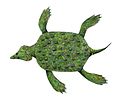| Ogmodirus Temporal range: Late Cretaceous, | |
|---|---|
 | |
| Paddle bone of KUVP 441 | |
| | |
| Cervical series of KUVP 441 | |
| Scientific classification | |
| Kingdom: | |
| Phylum: | |
| Class: | |
| Order: | |
| Suborder: | |
| Family: | |
| Genus: | †Ogmodirus |
| Binomial name | |
| †Ogmodirus martini Williston & Moodie, 1913 | |
| Synonyms | |
| |
Ogmodirus is an extinct genus of plesiosaur found in the Cenomanian-Turonian (Late Cretaceous) Greenhorn Limestone of Kansas. [1] [2] The type species, O. martini, was named by Samuel Wendell Williston and Roy Lee Moodie in 1913. [2]






